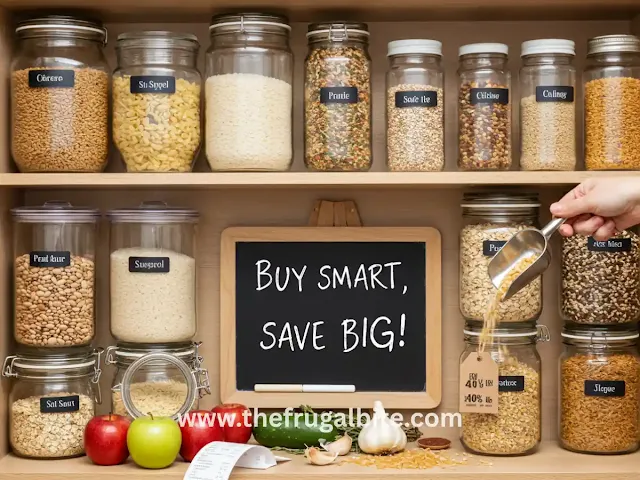Buy in Bulk: How to Save and Store Ingredients Like a Pro
 |
| Buy in Bulk: How to Save and Store Ingredients Like a Pro |
Introduction
Tired of weekly grocery runs draining your wallet and pantry space? Imagine slashing your grocery bill by 30% or more while always having key ingredients on hand. The secret? Buying in bulk. Purchasing larger quantities of pantry staples can lead to significant cost savings, reduce packaging waste, and minimize last-minute store trips.
But bulk buying isn’t just about grabbing the biggest bag of rice—it’s about
smart
selection and proper storage to avoid waste. In this guide, we’ll cover:
✔ The best foods to buy in bulk (and what to avoid)
✔ How to calculate real savings (unit pricing explained)
✔ Storage secrets to keep ingredients fresh for months
✔ Space-saving hacks for small kitchens
Let’s dive in and transform the way you shop and store!
Why Bother Buying in Bulk? The Undeniable Benefits
1. Significant Cost Savings (The Obvious Win)
Buying in bulk means lower unit prices. Here’s a quick comparison:
| Product | Standard Size (Price) | Bulk Size (Price) | Savings |
|---|---|---|---|
| Rice (per lb) | $1.50 (5 lb bag) | $0.90 (20 lb bag) | 40% |
| Olive Oil (per oz) | $0.50 (16 oz) | $0.30 (64 oz) | 40% |
Pro Tip: Always check the price per unit (oz, lb, or
count) to compare deals fairly.
2. Reduced Packaging Waste (Eco-Friendly Bonus)
Fewer individual packages mean less plastic and cardboard in
landfills—great for the planet!
3. Fewer Shopping Trips (Time & Convenience)
A well-stocked pantry means fewer last-minute store runs (and fewer impulse
buys).
4. Emergency Preparedness & Well-Stocked Pantry
Never worry about running out of pantry staples, bulk buys like
beans, rice, or canned goods during unexpected shortages.
Smart Bulk Buying: What to Buy (and What to Skip)
✅ Best Foods to Buy in Bulk
Dry Goods:
- Flour, sugar, rice, pasta, oats, quinoa (store in airtight containers)
- Beans, lentils (last 1-2 years if stored properly)
Canned Goods:
- Tomatoes, beans, tuna (shelf-stable for **2-5 years**)
Oils & Vinegars:
- Olive oil, coconut oil, apple cider vinegar (store in a **cool, dark place**)
Spices & Herbs:
- Whole spices (last longer than ground)
- Buy frequently used spices like cinnamon, cumin, and peppercorns in bulk
Frozen Goods:
- Meat, poultry, fish (vacuum-seal for long-term freezing)
- Frozen veggies & fruits (pre-portioned for smoothies)
Non-Food Items:
- Toilet paper, cleaning supplies, and pet food
❌ What NOT to Buy in Bulk
- Highly perishable items (fresh herbs, berries, dairy, unless used quickly)
- Items you rarely use (specialty flours, exotic spices)
- Oils that spoil fast (flaxseed, walnut oil)
- Anything untested (try a small size first!)
Calculating Your Savings: Is Bulk Buying Really Cheaper?
1. Understanding Unit Price
Divide the total price by quantity (e.g., $10 for 5 lbs of
flour = $2 per lb).
2. Compare Bulk vs. Regular Sizes
Use a unit price calculator app or check shelf tags in-store.
3. Factor in Potential Waste
If you won’t use it before it spoils, it’s not a deal
4. Consider Membership Fees
Costco and Sam’s Club require fees—ensure your savings outweigh the cost.
Mastering Bulk Food Storage (Keep It Fresh & Safe)
🔑 Fundamental Storage Principles
- Airtight containers (keep out moisture & pests)
- Cool & dark (prevents spoilage & rancidity)
- Label everything (contents + purchase date)
- FIFO method (First-In, First-Out) to prevent waste
🏺 Best Storage Containers
- Glass jars (Mason jars for flour, sugar)
- BPA-free plastic bins (stackable & lightweight)
- Vacuum sealers (ideal for meat & coffee)
- Mylar bags + oxygen absorbers (long-term storage)
❄️ Freezing Bulk Meats & Produce
- Wrap meat in freezer paper + vacuum seal
- Flash-freeze berries on a tray before bagging
Bulk Buying with Limited Space? No Problem!
- Go vertical (wall-mounted shelves, under-bed bins)
- Decant into smaller containers (keep a week’s supply handy)
- Share with a friend (split large purchases)
Common Bulk Buying Pitfalls (And How to Avoid Them)
- Over-buying → Stick to a list!
- Food waste → Store properly + FIFO
- Pests → Always use airtight containers
- Forgetting what you have → Label clearly
Conclusion: Start Small & Save Big
Buying in bulk is a game-changer, saving money, time, and reducing
waste. Focus on pantry staples, bulk buys first, master storage,
and watch your grocery bills shrink.
Ready to try? What’s your favorite item to buy in bulk? Share in
the comments!
📌 Loved this guide? Pin it for later or share with a friend!

